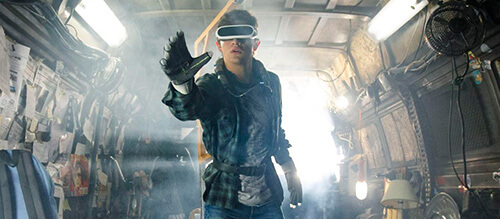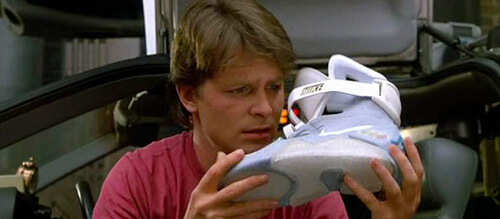How Science Fiction Movies Have Influenced Technology
This article was written exclusively for The Film Magazine by Craig Sheldon.
When we think of science fiction movies, there are certain moments that stand out to us as defining examples of the genre – Luke Skywalker finding out he’s the heir to a giant grey space ball of mass destruction, astronaut David Bowman tripping out on a psychedelic cocktail of space and time, and even Spock’s dying act of pressing his parted hand up against Kirk’s as he took one for the team; or the Many; or was it the few? I forget which.
But, what is science fiction really?
By definition, it’s science that isn’t real.
Or is it?
Well, for the most part, no. No it isn’t. But strip away all the humanoid looking aliens that all speak with the same mid-western American accents, and all the physics defying laser sword space-jitsu in galaxies far, far, away and what you’re left with are some very ground-breaking and revolutionary ideas, a lot of which have had a very real influence on modern technology.
Now, is this to say that all the gizmos and doo-dah’s we see brought to life on the big screen will one day have a shelf-price in our local grocery store? It’s very doubtful (and not just because in the future grocery stores will probably be a thing of the past. As probably will be the phrase ‘doo-dah’). But, to give credit where credit’s due, sci-fi has always had a pretty good track record when it comes to predicting the future. A record not even Nostradamus could sniff at.
It was in the early 1990’s that the world first began salivating at the notion of receiving electronic mail and also suffering through the dull and dreary music of ‘Spin Doctors.’ (Oops, sorry, I meant the dial-up connection.) But, before the ‘internet’ was a household tool, the idea of an ever-expanding entity that retained an endless array of knowledge was thoughtfully brought to the big screen in Star Trek: The motion Picture as the all-enveloping sentient machine ‘V’Ger’.
In the film, the crew of the USS Enterprise intercept a strange cosmic cloud making its way to Earth. In doing so, they encounter ‘Voyager 6’ (abbreviated to V’Ger) at the heart of the cloud; a long-lost space probe which was upgraded by an alien race and sent to traverse the cosmos to gain as much knowledge as possible. Now, I’m not saying that ‘V’Ger’ and the internet are completely comparable in terms of technology, given that is one is sentient and space bound, but the two do share some similar qualities.
When Star Trek: The Motion Picture was released in 1979, the home computer was still a growing market. Things like the internet were yet to be made available to the common man and the idea of downloading was an unknown concept. But ‘V’Ger’, much like the internet, is an ever-evolving entity that absorbs all and any information it can acquire (for better or worse) and has the ability to copy and transfer (or download) the character of Llia’s memories and thoughts into a robotic replica. So, while none of us are downloading memories into robotic replicas (unless you work for a super-secret branch of the government, of course) downloading has become something we all do on a regular basis.
So, to refresh: a cloud that stores infinite knowledge? Check. A constantly evolving and upgrading technology? Check. An ability to download all of its information? Check. Seems like the internet to me. Well done Star Trek, you get a cookie.
Now, say what you will about the Matrix trilogy (I’ll pause here to let you all vent your frustrations at the computer screen… …. …. All done? Good,) but it did for virtual reality what Vin Diesel did for bald men – it made it stylish.
Just like how the character Neo would sit back and plug himself into a simulated reality in the films, people today can put on a cheap as chips headset and transport themselves to a virtual world of endless possibilities with as little as a smartphone and a free app.
Recent advances in VR, like Sony’s Oculus head gear or even HTC’s VIVE now allow for even greater experiences in virtual reality, adding heightened interactivity to VR gaming and simulations. And, whilst the technology of VR might still be in it’s early stages, a future akin to that in the film Ready Player One – where everybody prefers to live a simulated life in “the Oasis” instead of facing the bleak and hopeless reality of the real world – might not be as far-fetched as it may have once seemed.
What’s more is that a virtual reality in which we can work and earn a living as our digital creations is another idea science fiction has suggested over the years. Want my advice? Go and register a cool avatar name now before all the good ones are gone. Just don’t bother trying “Where’s-WALL.E-88.” That one’s taken.
Whilst it can be said that a lot of science fiction technology in films exists purely as a cool visual to help boost ticket sales or as a convenient plot device to aid the hero on their quest, many of these ideas have the potential to change the shape of the world we live in. In the 1990 film Total Recall, self-driving taxis called “Johnny cabs” are as commonplace as any vehicle on the road and come fully installed with a robotic driver to liaise with and collect payment. In the film iRobot starring Will Smith, cars come with an auto-drive function as standard, allowing the driver to switch between manual and automatic with the push of a button.
Although the reliance on self-driving vehicles in the movies usually ends up with the technology backfiring for entertainment’s sake, the development of such a technology in real life aims to take away the risk of human error and provide a safer and more convenient way to travel. This is what the Brainiacs over at Google have done with their own autonomous car development company called WAYMO.
Using sophisticated laser beam and GPS technology to map the area, a WAYMO car can constantly record and relay information to programme its route. Not only have WAYMO managed to build fully operational autonomous cars, but they say they could be only five to ten years away from hitting the streets, and it’s not just WAYMO that are developing this technology – numerous car manufactures have their own driver-less prototypes in the works. Whether or not driver-less cars are a permanent replacement for the cars we drive today remains a question mark, but I’ll take a robot Cabbie over having to listen to my Uber driver’s political rant any day.
Remember in those Iron Man films how Tony Stark casually flips through digital files in mid-air and uses the floating trashcan like a basketball hoop for junk files? Well, soon you’ll be able to do that too (do you hear that? It’s a cheer heard all around the world from all those guys who grew an Iron Man goatee in 2008 and stuck with it despite every member of their family pleading with them to shave.)
Don’t get too excited; the technology is real, but it’s a little way off from becoming a household utility. A company in Japan called ITRI have created a wearable pair of glasses that allow you to bring up computer displays in mid-air and use it by simply touching your finger against a projected screen. The screen, which appears invisible to everyone else, is designed to give more privacy and also lets the user see the real world through the floating images (just so you don’t walk into a street lamp, or a matinee showing of an Adam Sandler movie by mistake). Unlike in the film Minority Report (pictured above) where Tom Cruise uses specially modified gloves to interact with all the digital displays as he filters through various crimes files, ITRI has designed the head-mounted display to react to the human finger using special sensors that detect the position of your finger and select whatever you point at. But, if you’re in the market for something a little less flashy, you can buy a Laser Keyboard that projects a laser display of a computer keyboard via Bluetooth onto any flat surface allowing you to type away at your table top or kitchen counter until your heart’s content.
Science fiction hasn’t just influenced technology in a practical way. More convenient transport and multi-lingual phones are all well and good, but sci-fi has also changed other aspects of our lives.
One of the most obvious of these changes has been to the contents of our wardrobes. Everything from androgynous silver jumpsuits to ultra-sexy spandex pieces are common in the movies, but when it come to wearable technology, a few films have had more of an impact than others; and I’m not just talking watches that you can steer your sports car with like in Casino Royale, I’m talking about the good stuff.
Remember those self-tying shoes from Back to the Future Part II? They exist. Nike have finally delivered on what Robert Zemeckis promised us 29 years ago. They’re called Nike Air Mags, and by squeezing a button on the side of the shoe, it tightens and loosens to the correct size of the wearer. Its not exactly the most critical of purchases, but if you told me that you didn’t want to have a pair, then I’d know you were lying.
My conclusive thought regarding sci-fi’s lasting impact on real technologies is this: as technology catches up with science fiction, and all those cool things we marvelled at as children after coming out of the cinema screen slowly start to become a reality, perhaps all our favourite sci-fi films of yesterday will be redefined as simply…films. So here’s hoping the next generation of science fiction inspires more amazing technology.
I for one can’t wait for mobile phones that don’t lose signal when you enter a tunnel, but I guess there’s an argument that such a technology more accurately falls under the genre of fantasy.
Written by Craig Sheldon




